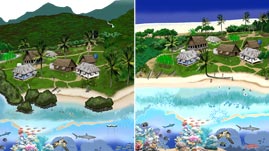Teachers' Domain - Digital Media for the Classroom and Professional Development
User: Preview

Source: Micronesia Conservation Trust
This interactive activity adapted from the Micronesia Conservation Trust examines the three primary ecosystems of Pacific high islands and atolls. These ecosystems—terrestrial, coastal, and reef—provide many services to island communities. However, they also face threats from both human activities and climate change. The interactive activity details the services and the threats. It also provides real-life examples of Pacific Island communities that are already experiencing changes and taking action. These actions, or adaptations, are designed to strengthen their ecosystems and the overall resilience of their island.
Here are suggested ways to engage students with this interactive and with activities related to this topic.
Before the interactive activity: There are a number of terms that have specific meanings in the context of climate change. Discuss the following terms and definitions with your class.
Before the interactive activity: The “Earth system” is used as an organizing principle to help students understand that air, water, land, and life are all connected to one another. Changes in one part of the Earth system will influence changes in other parts of the system.
After the interactive activity: Challenge students to examine the impacts of climate change that are identified in the interactive activity. Have them suggest how each impact might lead to another impact within the Earth system.
Small-group activity: Have students think about their own island setting, and ask them to identify a threat similar to the ones in the interactive activity. Divide the class into small groups, and have each group develop ideas and strategies to resolve the problem(s). You may later have the groups present their ideas to the rest of the class.
Research project—individual: Have students compare the threats related to climate change on high islands with the threats related to climate change on atolls. Are the threats the same for the ecosystems on both island types? For example, should sea level rise concern residents on both island types? Do any threats apply to one but not the other? If so, do students understand why? After comparing the threats, have them compare ecosystem adaptations. For example, how would a community on each island type act to safeguard its water supply?
Class activity: Ask students to make a concept map that summarizes the impacts of climate change in island environments. You may have them focus on just their island type or, if they have reviewed both types in the interactive, high islands and atolls. Have students color-code their maps according to which ecosystem is affected by each climate change-related threat. For example, a concept map for a high island should include impacts associated with sea level rise, such as of the loss of mangroves and increased beach erosion. So students would highlight or circle these impacts in a color assigned to represent coastal ecosystems. Once students have completed their maps, have them discuss whether their own community is or might one day experience any or all of these climate change impacts.
Class activity or small-group activity: As a class or in small groups, have students compare and contrast the examples of community adaptations that appear in the interactive. Use the following questions to guide their discussion:
 Loading Standards
Loading Standards